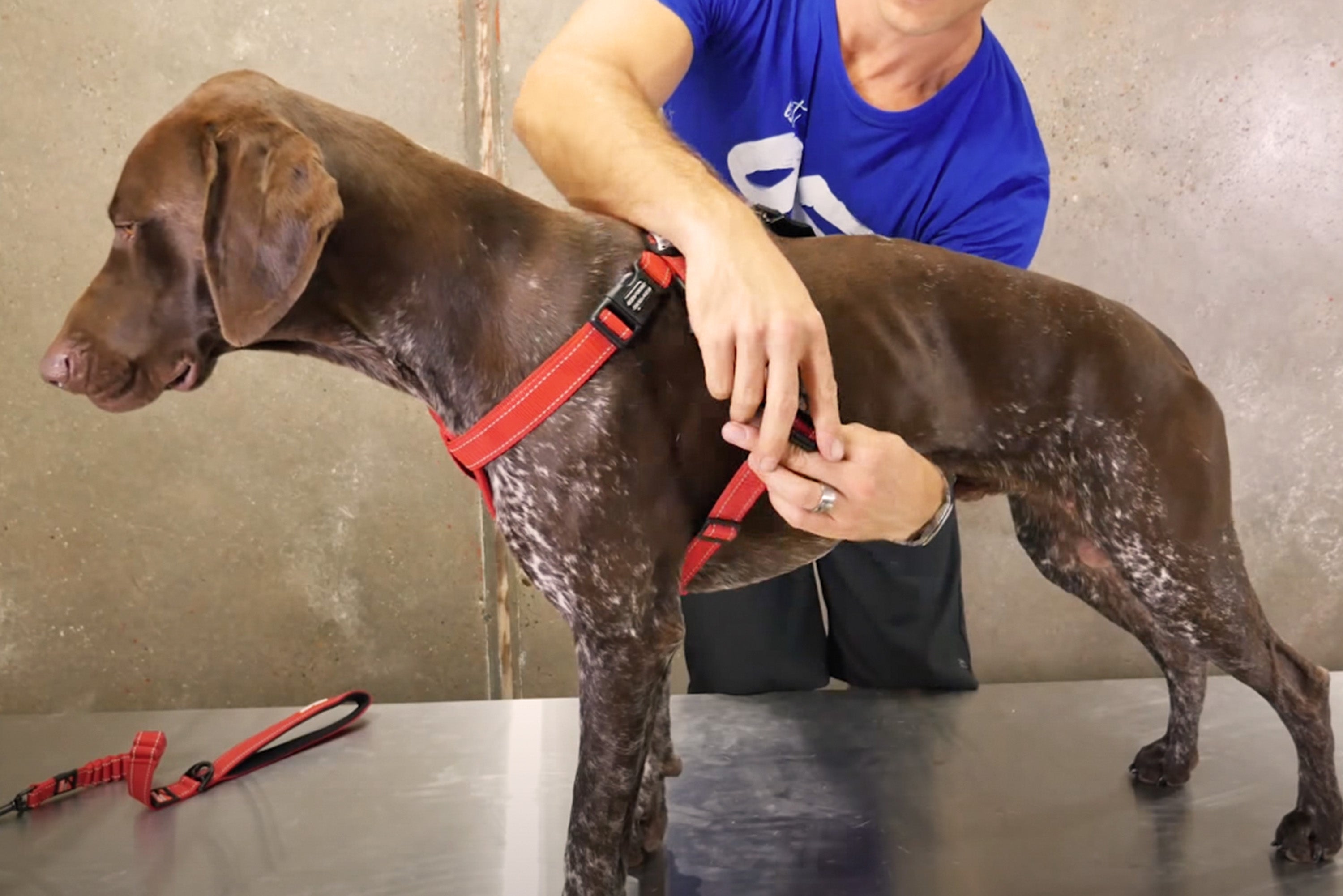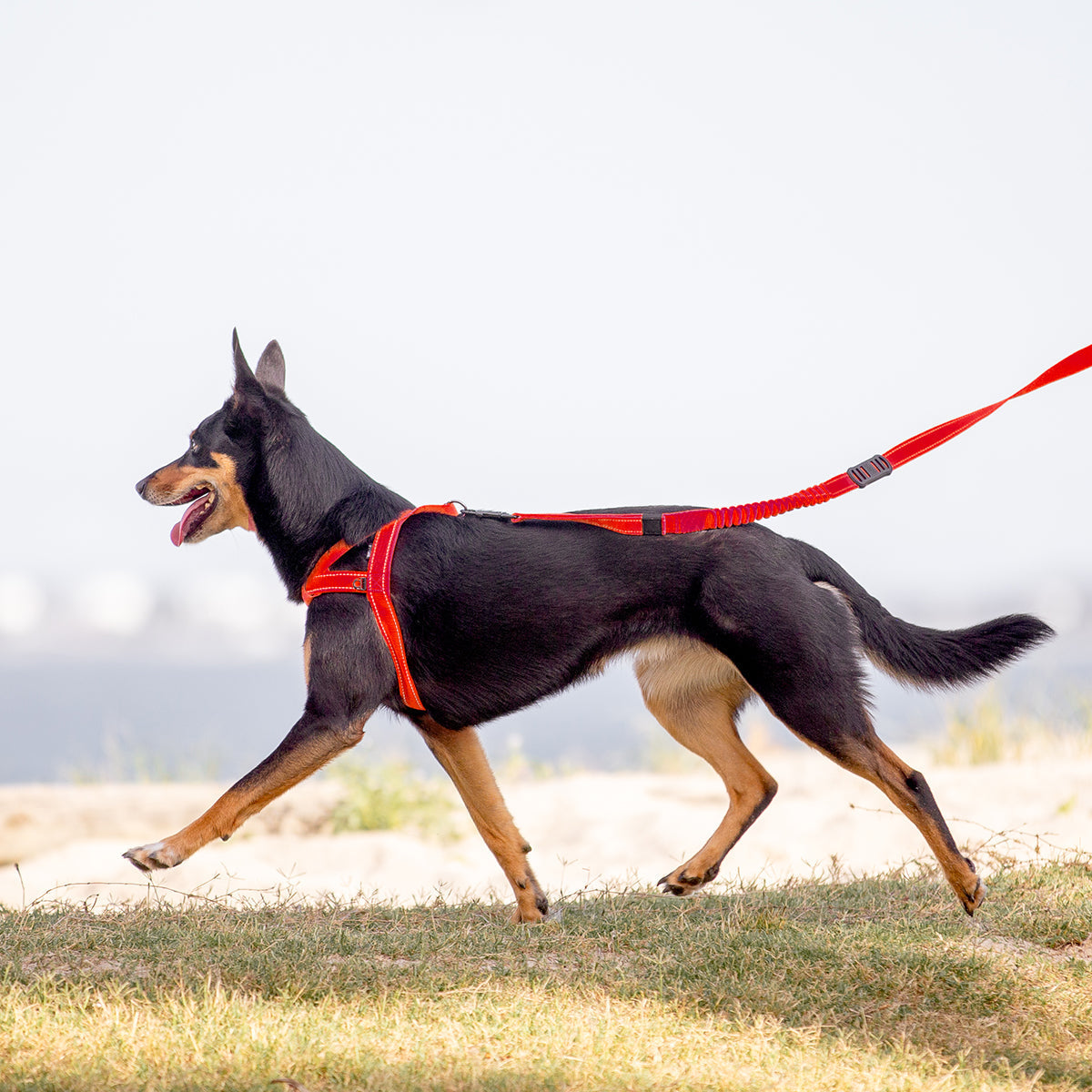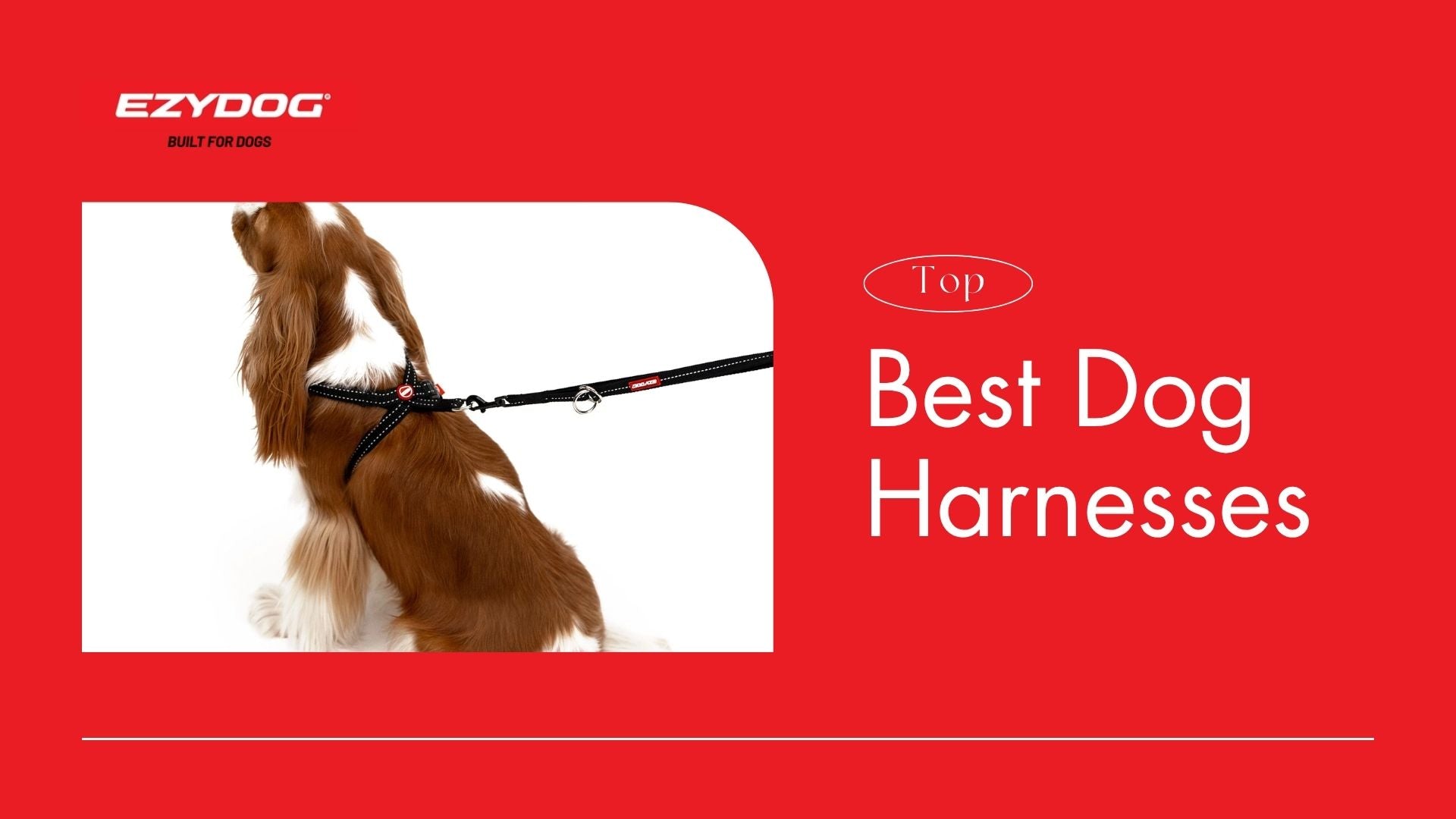
How to Put On a Dog Harness: A Complete Step-by-Step Guide
Choosing to use a dog harness is one of the best decisions you can make for your dog's comfort and safety. Harnesses distribute pressure more evenly across the chest rather than concentrating it on the neck, helping prevent injuries and making walks much more enjoyable for both of you.
Whether you're fitting a harness for the first time or refining your technique, understanding the correct method ensures a stress-free experience for you and your furry companion.
Different Types of Dog Harnesses
Before learning how to fit a harness, it’s important to recognise the type you're working with. Harnesses are designed differently based on your dog's size, behaviour, and walking style.
Each type has a slightly different fitting method, so knowing the style you have makes the process easier and more effective.
The most common types include:
-
Step-In Harness: This design requires your dog to place their front paws into two loops on the ground, after which the harness is pulled up and fastened over the back. It’s ideal for dogs who are sensitive about having things slipped over their heads.
-
Over-the-Head Harness: In this style, the harness slips over the dog’s head, and the chest and belly straps secure around the body. It's one of the easiest harness types to use once your dog becomes familiar with it.
-
Vest-Style Harness: Typically padded for extra comfort, these harnesses either step-in or slip-over, offering more coverage across the chest and body. They are perfect for smaller dogs, puppies, or dogs with sensitive skin.
Quick Comparison Table
|
Harness Type |
How to Put It On |
Best For |
|
Step-In Harness |
The dog steps into two loops, with strap clips on the back. |
Dogs who dislike things over their head. |
|
Over-the-Head Harness |
Slip over the dog’s head, clip straps around the chest. |
Most dogs, simple to use once fitted. |
|
Vest-Style Harness |
Slip over or step-in, then fasten Velcro/buckles for added comfort. |
Small dogs, puppies, or sensitive dogs. |
Knowing these types helps you approach the fitting process with the right technique and mindset.
How to Put On a Dog Harness
Fitting a harness correctly takes a combination of calm handling, patience, and attention to detail. Although the steps differ slightly depending on the style, the overall goal is the same: ensure your dog feels comfortable and secure.
How to Put On a Step-In Harness
Step-in harnesses are great for dogs who get anxious when things go over their heads. Here's how to fit it properly:
-
Lay the Harness Flat: Place the harness fully opened on the ground, ensuring the two leg openings are clearly visible and untwisted. This helps you position your dog correctly without fumbling during the process.
-
Guide Your Dog to Step In: Gently encourage your dog to place one paw into each loop. Using treats or a soothing voice can help if your dog is hesitant.
-
Pull Up and Clip: Lift the harness sides up around your dog's torso and fasten the clips securely over the back. Double-check that the straps aren’t twisted.
-
Adjust for Fit: Once secured, check that the harness is snug but comfortable. Adjust the straps if needed before clipping on the lead.
For an easier experience, browse our collection of step-in dog harnesses, designed for quick and comfortable fitting.
How to Put On an Over-the-Head Harness
An Over-the-Head harness is a common favourite for its simplicity. Here's the correct approach:
-
Slip the Harness Over the Head: Gently guide your dog’s head through the neck opening, ensuring it’s not too tight around the neck.
-
Position the Chest Strap: Let the chest piece fall naturally between the front legs. This ensures that the weight distribution stays even during walks.
-
Secure Around the Chest: Wrap the side straps around your dog’s ribcage and clip them securely. Listen for a "click" to confirm it’s properly fastened.
-
Adjust for Comfort: Tug gently on the harness to check it doesn’t move excessively, but still allows full range of motion.
The Quick Fit Harness is a good example of this style — lightweight, minimal adjustments needed, and very user-friendly.
 How to put on the Quick Fit Harness:
How to put on the Quick Fit Harness:

For the instructional video watch it now:
How to Put On a Vest-Style Harness
Vest-style harnesses are prized for their comfort, especially for sensitive or smaller dogs. Here's how to use one:
-
Open and Prepare the Harness: Unfasten all straps or Velcro before you begin. Lay it flat and ensure you understand whether it's a slip-over or step-in model.
-
Place Correctly on Your Dog: Depending on the design, either guide your dog’s head and paws into place, or gently drape it over their back.
-
Fasten All Closures: Secure all Velcro, buckles, or clips firmly. Good-quality vest harnesses typically have multiple closures for added security.
-
Final Fit Check: Ensure the harness fits close to the body without pinching or limiting movement.
The Chest Plate Harness offers excellent chest support and can be ideal for active walks or training sessions.

This kind of harness evenly distributes the load across the dog’s chest and has a wide range of adjustment. This harness can be placed on quickly and easily.
How to put this dog harness on:

For the instructional video watch it now:
Model-Specific Fitting Tips
-
Centre the EVA chest support on your dog’s chest.
-
Adjust both side straps evenly.
-
Ideal for everyday use and comes with a car restraint.
-
Slide over the head and buckle on one side.
-
Designed for fast fitting with minimal adjustments.
-
If you're looking for how to put on a perfect-fit dog harness quickly, this model is ideal.
-
Ideal for escape artists and training purposes.
-
Loops behind the front legs for secure control.
-
Perfect for active dogs.
-
Contoured fit with a soft inner lining for comfort.
-
Certified crash-tested.
-
Adjust while off your dog, then secure using your vehicle’s seatbelt.
How to Adjust and Check If a Dog Harness Fits Properly
A poorly fitted harness can turn an enjoyable walk into a frustrating or even dangerous experience. Always take a moment to check the fit after putting it on.
Key fit checks include:
-
Two-Finger Rule: Slide two fingers between the harness and your dog’s body. If it’s too tight to fit your fingers or too loose so that you can wiggle more than two, adjustments are necessary.
-
Freedom of Movement: Watch your dog walk, sit, and turn. The harness should move naturally with them, not pull or bunch up awkwardly.
-
No Rubbing or Chafing: After a walk, inspect for any signs of hair loss, redness, or discomfort around the harness area — signs that adjustments are needed.
Getting these basics right ensures your dog remains comfortable, safe, and happy while wearing their harness. Need sizing help? View our Size Guide
What If the Harness Doesn’t Fit Right?
-
Keeps slipping off? – Check if the belly strap is snug and buckled correctly.
-
Chafing or rubbing? – Ensure straps are flat and not overtightened.
-
Dog resist wearing it? – Reintroduce slowly with treats and short wear periods.
-
Unbalanced or lopsided? – Remove and reapply, adjusting each side evenly.
Tips for Making It Easier to Put On a Harness
Some dogs, especially those new to harnesses, may resist at first. Fortunately, building positive associations can ease the process significantly.
Here’s how to make it easier:
-
Introduce the Harness Gently: Let your dog sniff and investigate the harness before attempting to put it on. This builds familiarity.
-
Use Positive Reinforcement: Reward calm behaviour with treats, praise, or gentle pats. This creates a connection between the harness and positive outcomes.
-
Practice Short Sessions: Don’t rush. Initially, just placing the harness on without securing it can be enough. Gradually increase the steps as your dog becomes more comfortable.
-
Reward After Fitting: Once the harness is on, offer a special treat or immediately take your dog on a fun walk. This solidifies the idea that the harness signals good times.
Patience during the initial stages pays off with a lifetime of easy harnessing experiences.
Common Mistakes to Avoid
Even small errors can make a big difference when fitting a harness. Here’s what to avoid:
-
Using a Harness That’s Too Loose: Dogs can easily back out of loose harnesses, especially when startled. Always check the fit before every walk.
-
Overtightening the Straps: While you want a secure fit, overly tight harnesses can cause discomfort, chafing, and even injury over time.
-
Skipping Regular Adjustments: Dogs' bodies can change with age, weight fluctuations, or even seasonal coat thickness. Make minor adjustments every few months.
-
Choosing the Wrong Harness Type: Not every harness fits every dog. Strong pullers, for instance, may need a front-clip harness for better control, whereas smaller dogs might benefit more from a padded vest.
By being mindful of these potential pitfalls, you can ensure that every walk starts safely and positively.
Quick Safety Tips
Beyond fitting and comfort, harness safety should never be overlooked. Here are simple safety habits to follow:
-
Inspect Regularly: Check buckles, stitching, and material strength after regular use. Replace worn-out harnesses immediately.
-
Supervised Use Only: Remove the harness when at home, unless recommended otherwise, to prevent snagging or chewing incidents.
-
Replace Damaged Harnesses: Any visible damage could compromise the harness’s ability to hold during a walk, putting your dog at risk.
Practising these habits can prolong the life of the harness and keep your dog safer over time.
Still Not Sure Which Harness Is Right?
Here’s a quick guide:
-
For puppies or new users: Quick Fit Harness
-
For car travel: Drive Car Harness
-
For pullers or training: Crosscheck Harness
-
For active dogs: Express Harness
FAQS: How to put on a Dog Harness
1. Should I attach the leash to the front or back of a harness?
For everyday walks, use the back clip. If your dog tends to pull, a front-clip harness gives you more control by gently redirecting them. See our non-pull harnesses for better walking experiences.
2. What’s the easiest type of harness to put on?
The Quick Fit Harness is designed for fast, single-buckle fitting—ideal for squirmy or first-time dogs.
3. Why won’t my dog let me put the harness on?
It could be fear, discomfort, or unfamiliarity. Try a slow introduction using treats and praise. Let them sniff the harness before putting it on, and avoid forcing it.
4. Do front-clip harnesses stop pulling?
Yes, they help by shifting your dog’s forward momentum sideways, making pulling less effective. Explore our Crosscheck Harness for an effective no-pull option.
5. Are harnesses safer than collars?
Harnesses distribute pressure across the chest and shoulders, reducing strain on the neck, especially important for puppies, small dogs, or pullers. See our harness collection for safer alternatives to collars.
6. How do I know if the harness is on backwards?
The D-ring or clip should be positioned over your dog’s back or chest (depending on style), and all straps should lie flat without twisting. If it looks unbalanced, it might be on incorrectly.
7. Why does my dog freeze when I put the harness on?
Some dogs feel overwhelmed. Use a calm voice, treats, and short practice sessions to desensitise them. Start with just placing the harness on their back without fastening it.
8. How do I put on a harness on a scared or reactive dog?
Go slowly. Let them approach the harness, use plenty of rewards, and avoid sudden movements. Consider harnesses like the Chest Plate Harness for secure, easy fitting.
9. Can I use a harness in the car?
Yes, but only with crash-tested options like our Drive Car Harness designed specifically for travel safety.
10. What is the best harness for small dogs?
Small dogs often benefit from lightweight, easy-to-adjust harnesses. Try the Quick Fit Harness or view all small dog harnesses.
Final Thoughts
Now that you know how to put on, adjust, and use a dog harness properly, you're one step closer to safer, more enjoyable walks with your pup. A well-fitted harness can change everything—from reducing pulling to giving you better control, especially in busy or exciting environments.
At EzyDog NZ, we design every harness with real dogs and real adventures in mind. Whether you're after an everyday walking essential, a travel-safe option, or a training solution, we’ve got you covered.
Ready to find the perfect fit? Explore our full range of high-quality, vet-recommended harnesses designed for dogs of all sizes and personalities.




Leave a comment
This site is protected by hCaptcha and the hCaptcha Privacy Policy and Terms of Service apply.